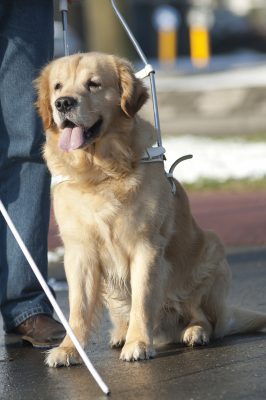×


We have detected your country as:
Please click here to go to the USA website or select another country from the dropdown list.
by: Kathy DeGagne, BFP Staff Writer
 In a small community in central Israel, something momentous is about to happen: a mother golden retriever is ready to give birth to a litter of puppies. For dog-lovers everywhere, the birth of puppies is always eventful, but these particular puppies are destined for greatness—they will be raised solely as guide dogs for the blind.
In a small community in central Israel, something momentous is about to happen: a mother golden retriever is ready to give birth to a litter of puppies. For dog-lovers everywhere, the birth of puppies is always eventful, but these particular puppies are destined for greatness—they will be raised solely as guide dogs for the blind.
Guide Dogs for Israel
The guide dog movement originally began during WWI, when soldiers who were blinded by poisonous gas needed help to navigate their new reality. One day, a doctor working with blind veterans noticed that a German shepherd dog was intuitively guiding a blind soldier. Dogs were then called into service to improve the quality of life for these visually impaired servicemen.
In Israel, it wasn’t until 1991 that the Israel Guide Dog Center for the Blind was established by Noach Braun, a former Israel Defense Forces (IDF) soldier who worked with dogs during his time in the military. Braun saw the need for blind Israelis to have dogs trained to obey commands in Hebrew. Before that time, Israelis had to travel to the United States and other parts of the world to get a guide dog—but first, they had to learn English, because the dogs were only trained in English commands.
After learning how to partner with their dogs on US soil, blind Israelis then had to return home, where the environment proved to be much more challenging for the dogs and their owners than the streets of the US. The sidewalks were narrower and cobbled with limestone, cars and motorcycles were often parked on the sidewalks and dumpsters regularly blocked walkways and stairways. Also problematic were the thousands of stray cats that wander the streets of every Israeli city—a huge feline distraction for dogs not used to so many.
Today, the Israel Guide Dog Center for the Blind is the only accredited guide dog training center in the Middle East. The center breeds and raises Labrador retrievers, golden retrievers and Labrador–retriever mixes. Though costing upwards of US $25,000 to raise and train, guide dogs are provided free of charge to anyone who needs one, whether they are Christian, Arab, Muslim or Jewish. The center depends largely on donations to meet the need, but currently only 1% of the blind population of Israel has a guide dog.
From Puppyhood to Adolescence
The little puppies will stay at the center for 2–3 months, playing with one another and getting used to their handlers. Then they are fostered out to volunteers for basic training.
Most of the volunteers are university students who raise the puppies for about 16 months. The pairing of dogs with university students has proved to be a match made in heaven. A student’s life is usually very active, and the puppies accompany their foster parents everywhere—to class, on the train and bus, along busy streets, to parties and jobsites. They then get used to being in all kinds of situations without getting scared or distracted.
From puppyhood to adolescence, the dogs learn basic obedience with their foster parents, become socialized with strangers and other animals and prepare for the advanced training still to come. Many students consider their participation in the training program a chesed (kindness) to others, but saying goodbye to their beloved charges is one of the hardest things they may ever have to do. Yet they know that the dog must do what it was born to do, and the foster parents can take satisfaction in the crucial part they’ve been able to play in the training.
The dogs are then introduced to prospective families in order to match the different dogs with owners based on personality as well as their size and gait. The dogs and their owners will eventually develop a very deep relationship. The word for dog in Hebrew is kelev and can be translated “full of heart,” a powerful description of a dog’s wholehearted devotion to its owner.
Trust in the Palm of Your Hand
 After the young adolescent dogs are returned to the center, they go through a very rigorous four-month training course. A guide dog mobility instructor will take over the reins and train the dog and then train the owner. Even the scores of stray cats in the center’s neighborhood aid in the training. The cats are cared for by the staff and help the dogs get used to having multiple cats around.
After the young adolescent dogs are returned to the center, they go through a very rigorous four-month training course. A guide dog mobility instructor will take over the reins and train the dog and then train the owner. Even the scores of stray cats in the center’s neighborhood aid in the training. The cats are cared for by the staff and help the dogs get used to having multiple cats around.
Only about 50–60% of trained dogs will qualify as guide dogs, depending on their ability to calmly react to distractions, such as smells and other animals. The others will be donated for special needs, especially autistic children and soldiers suffering from PTSD, ensuring that their training is never wasted.
The center does not consider the dogs as tools, but rather as partners. It often takes about six months to build trust between the dog and its owner, but eventually they learn to intuitively read one another’s needs and trust that those needs will be met. Their interaction becomes fluid and they are able to function as one unit.
A guide dog can mean freedom from the isolation and paralysis often felt by those who can’t see—but who are now able to work and feel a part of society again. A guide dog literally becomes its owner’s eyes, as together they navigate the daunting world outside the front door.
Photo Credit: see photos for photo credit
All logos and trademarks in this site are property of their respective owner. All other materials are property of Bridges for Peace. Copyright © 2024.
Website Site Design by J-Town Internet Services Ltd. - Based in Jerusalem and Serving the World.